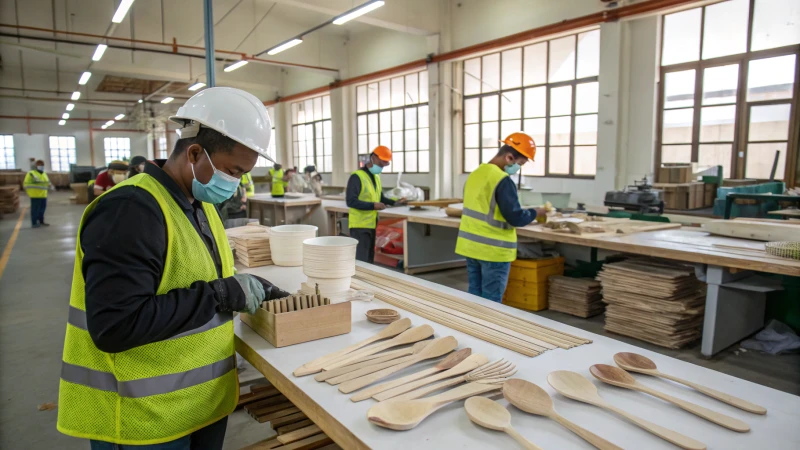
Imagine a world where every fork or spoon we use leaves no trace behind. Sounds ideal, right?
The biggest challenges in manufacturing high-quality disposable wooden cutlery revolve around finding sustainable wood sources, ensuring precision craftsmanship, maintaining rigorous quality control, and meeting stringent environmental standards. These elements are essential to creating durable, functional, and eco-friendly cutlery that meets consumer expectations.
When I first started exploring the world of eco-friendly products, I didn’t realize just how complex creating something as simple as wooden cutlery could be. Each piece must not only serve its functional purpose but also align with stringent sustainability practices. It’s about balancing nature with need, and every step of the way presents a new challenge. Let’s delve deeper into these challenges and explore some of the innovative solutions that are paving the way for a greener dining experience.
Sourcing sustainable wood is a major challenge.True
Finding eco-friendly wood that meets quality standards is difficult.
Environmental standards do not affect cutlery production.False
Adhering to environmental regulations is crucial for manufacturers.
How Does Material Selection Impact Wooden Cutlery Quality?
When it comes to wooden cutlery, the material choice isn't just about aesthetics—it's a game-changer for quality and sustainability.
Material selection plays a crucial role in wooden cutlery quality by determining durability, safety, and eco-friendliness. Opting for hardwoods like birch or bamboo enhances strength and sustainability, ensuring both functionality and environmental responsibility.
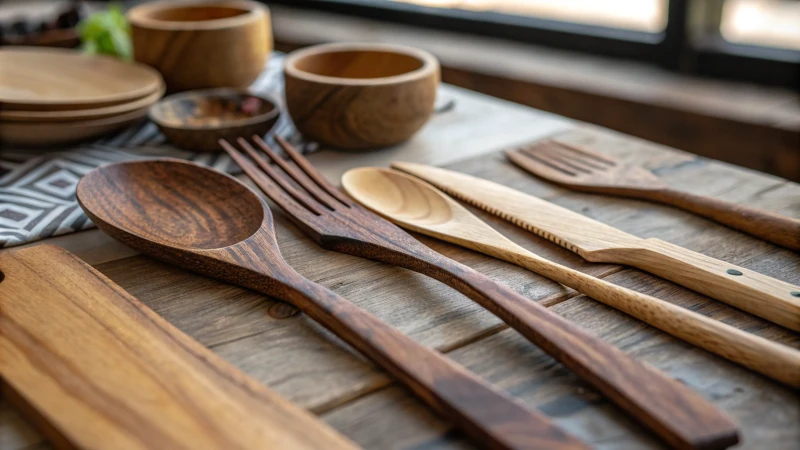
Types of Wood: Hardwoods vs. Softwoods
I've always believed that the foundation of any great product lies in the materials you choose. This couldn't be truer than when selecting wood for cutlery. Once, during a workshop on sustainable materials, I learned firsthand how hardwoods, such as birch and bamboo1, stand out due to their robustness and eco-friendly nature. These woods, with their resistance to wear and splintering, promise a safe and enjoyable dining experience.
| Wood Type | Attributes | Benefits |
|---|---|---|
| Birch | Dense, fine-grained texture | Durable, smooth finish |
| Bamboo | Fast-growing, renewable | Eco-friendly, robust |
On the flip side, softwoods like pine might remind me of that flimsy feeling you get with a cheap picnic set—prone to damage and not ideal for frequent use.
Impact on Usability and Safety
Imagine savoring a delicate dish at a luxury restaurant2, where every detail counts. The feel of the cutlery in your hand can significantly enhance or detract from the overall experience. Hardwoods provide that satisfying heft and smoothness that elevates dining into an art form.
Safety is another critical aspect I never overlook. Quality woods undergo stringent treatments to eliminate harmful chemicals and allergens, reducing health risks—a priority I hold dear, especially when catering to health-conscious clients.
Sustainability and Environmental Considerations
Choosing sustainable materials is like giving back to nature. Bamboo is a personal favorite because it grows rapidly without pesticides, ticking all the eco-friendly boxes for cutlery. It's a choice that aligns with my commitment to sustainability.
Sourcing wood from responsibly managed forests ensures that the environmental footprint remains minimal—a principle that resonates deeply with organizations aiming for green credentials, such as public sector procurement3.
Cost Implications of Material Selection
While initially hardwoods might seem pricier than softwoods, their durability offers long-term savings. I remember advising a fast-food chain on this very issue—opting for hardwood meant fewer replacements and ultimately lower costs. For large operations like fast-food chains4, this choice proves economically wise.
In essence, thoughtful material selection not only crafts high-quality wooden cutlery but also meets user expectations while upholding environmental standards—a balance I strive to achieve in all my projects.
Hardwoods are more durable than softwoods for cutlery.True
Hardwoods like birch and bamboo resist wear better than softwoods, enhancing durability.
Softwoods are the preferred choice for luxury dining cutlery.False
Hardwoods are preferred in luxury settings for their strength and smooth finish.
What are the key production challenges for wooden cutlery?
Ever wondered what goes into making the wooden cutlery that graces eco-friendly tables worldwide? It's more challenging than you might think!
The main production challenges for wooden cutlery involve sourcing sustainable wood, maintaining quality control, and ensuring hygienic manufacturing processes. These hurdles can be addressed by partnering with certified suppliers, implementing strict quality checks, and investing in modern sanitation technology.
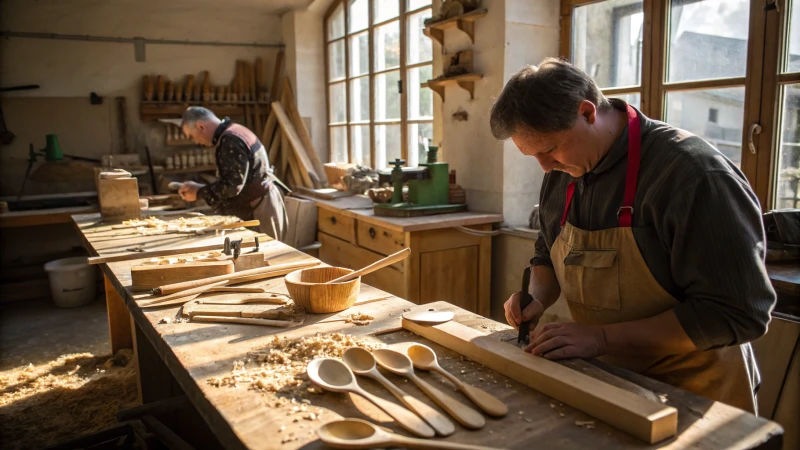
Sourcing Sustainable Wood
You wouldn't believe the treasure hunt I embarked on to find reliable sources of sustainable wood. It's like being a detective, piecing together a puzzle of certifications and responsible harvesting practices. Each supplier I consider undergoes rigorous scrutiny to ensure their wood meets our environmental standards. It's a dance of trust and diligence, but when I find that perfect match, it's like striking gold.
Maintaining Quality Control
Quality control is the backbone of our production process. I remember holding a freshly crafted fork, its smooth surface glinting under the light, yet knowing it had passed countless inspections. We test for everything from splintering to chemical safety, ensuring that every piece is not just a utensil but a testament to our commitment to safety and durability. Our quality assurance programs5 are thorough, leaving no room for compromise.
| Quality Control Checklist | Description |
|---|---|
| Splinter Tests | Ensure no sharp edges |
| Chemical Analysis | Verify non-toxicity |
| Strength Tests | Confirm durability |
Ensuring Hygienic Manufacturing Processes
Hygiene is non-negotiable. As we produce items destined to touch food, I invest in state-of-the-art technologies that ensure our facilities are as clean as they are efficient. From sterilization techniques to automated cleaning systems6, every step is designed to maintain impeccable standards.
Overcoming Cost Implications
The cost of producing wooden cutlery often surprises people. It's more than just the raw materials; it's about sustainable practices and investments in quality. Balancing these costs with competitive pricing is like walking a tightrope, but with strategic planning, it becomes a dance rather than a struggle.
Innovation in Production Techniques
Innovation is my secret weapon against traditional challenges. Utilizing advanced techniques like CNC machines for precision cutting not only reduces waste but also boosts efficiency. Embracing innovative technologies7 allows me to stay ahead in the game, ensuring our cutlery is as refined as it is responsible.
Navigating through these challenges requires a blend of tenacity and creativity. Every decision is a step toward crafting not just a product but a promise of sustainability and quality. It's this journey that transforms challenges into milestones.
Sourcing sustainable wood is a minor challenge for manufacturers.False
Sourcing sustainable wood is a major challenge due to certification needs.
Quality control includes testing for splintering in wooden cutlery.True
Quality control involves splinter tests to ensure no sharp edges.
What are effective ways to improve quality control in wooden cutlery manufacturing?
Discovering how to boost quality control in wooden cutlery production isn't just about meeting standards—it's a commitment to sustainability and craftsmanship. Let's dive into strategies that truly make a difference.
To enhance quality control in wooden cutlery manufacturing, focus on selecting high-grade materials, utilizing advanced technology in production, and conducting regular audits. This approach ensures that the products consistently meet safety and environmental standards.
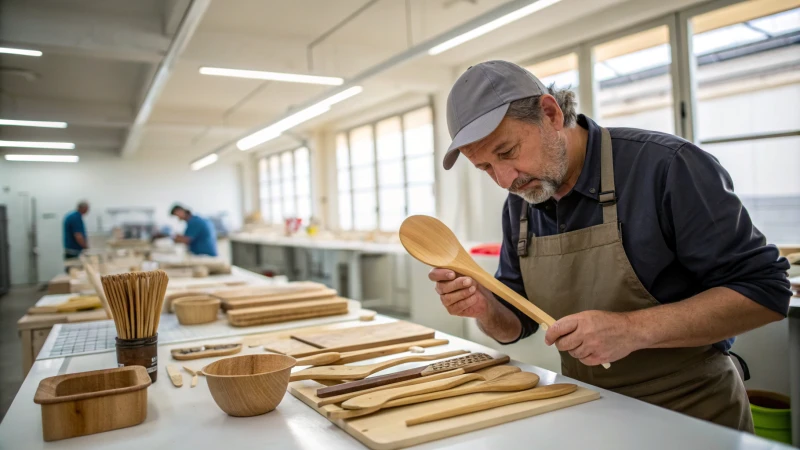
Material Selection: The Foundation of Quality
When I think back to my first venture into sourcing wood for cutlery, I remember feeling overwhelmed by the sheer variety. It was like standing at the crossroads of a forest, each path offering a different promise of quality and sustainability. Choosing the right wood is paramount—it’s the backbone of superior cutlery. I quickly learned that prioritizing wood from sustainable forests8 not only supports ecological balance but also ensures consistent quality. Every batch of wood is inspected meticulously for defects and texture uniformity, much like a chef carefully selects ingredients to create a masterpiece. Implementing a robust supplier verification system is critical; it’s like having a trusted guide on this journey, ensuring we only get the best materials.
| Criteria | Description |
|---|---|
| Sustainability | Certified eco-friendly sourcing |
| Consistency | Uniform texture and color |
| Strength | Durability under regular use |
Advanced Production Techniques
Incorporating modern machinery was another revelation for me—it's akin to upgrading from a typewriter to a computer. Technologies like CNC routers have revolutionized how we shape each piece of cutlery with precision, minimizing waste and enhancing sustainability. I remember the first time we integrated automation systems9; it was like watching a symphony of efficiency unfold before my eyes, reducing human error and achieving unparalleled consistency.
- Benefits of Automation:
- Reduces production time
- Increases uniformity
- Lowers operational costs
Process Audits and Quality Assurance
Regular audits have become a cornerstone of our process, much like routine check-ups are essential for health. They highlight areas for improvement along the production line. Establishing a quality assurance team that conducts periodic inspections ensures we maintain the highest standards. I vividly recall how implementing thorough checks on regulatory compliance10 allowed us to consistently meet safety and environmental standards.
- Key Audit Points:
- Inspection of finished goods for defects
- Review of employee training programs
- Verification of sanitation procedures
Embracing these strategies has allowed us to enhance our wooden cutlery's quality control significantly. It's not just about creating safe and durable products—it's about building a reputation in the market that reflects our commitment to excellence and sustainability.
Sourcing wood from certified forests ensures eco-balance.True
Certified forests adhere to sustainable practices, maintaining ecological balance.
Automation increases production costs in cutlery manufacturing.False
Automation reduces operational costs by streamlining processes and minimizing errors.
How Does Sustainability Impact the Manufacturing Process?
Imagine walking through a factory where every choice contributes to a healthier planet. That's the power of sustainability in manufacturing.
Sustainability in manufacturing involves selecting eco-friendly materials, utilizing energy-efficient processes, and implementing waste reduction strategies. These practices not only enhance operational efficiency and reduce environmental impact but also align with the growing consumer demand for green products.
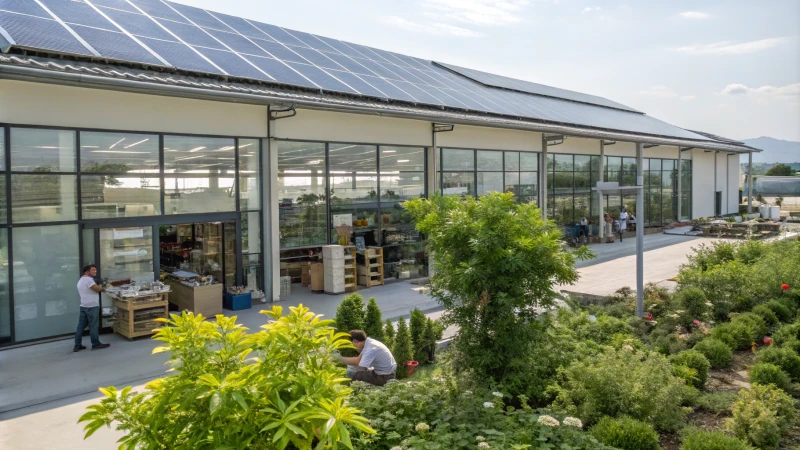
Incorporating Sustainable Materials
I remember visiting a factory that was all about sustainable practices—it was eye-opening. They chose recycled metals and biodegradable polymers, and I could see the immediate benefits: less waste, fewer emissions, and even reduced costs. It's like they hit the sustainability jackpot! Companies using recycled aluminum11 are not only cutting down on emissions but also trimming down their energy bills.
Energy Efficiency in Production
Watching solar-powered machines at work was like seeing the future unfold. It reminded me of how much energy traditional processes gulp down. Embracing solar or LED technologies can really turn the tables. I read about factories utilizing solar energy12 that are not only slashing their energy costs but also shrinking their carbon footprint. It's a win-win!
Waste Reduction Strategies
The concept of lean manufacturing seemed complex at first, but seeing it in action clarified everything. It's all about cutting waste without losing productivity—a balancing act that many get right. Zero-waste initiatives are catching on, and I've noticed significant savings in places that have embraced them. Adopting zero-waste initiatives13 is like giving the environment a big bear hug while also boosting efficiency.
Meeting Consumer Demand for Green Products
I've seen firsthand how eco-conscious consumers gravitate towards brands that embrace sustainability. It's fascinating how incorporating eco-friendly practices into manufacturing can enhance a brand's reputation. Brands that shout about their eco-friendly practices14 don't just gain loyalty; they inspire it. People love supporting brands that care, and I totally get why!
| Aspect | Sustainable Practice | Benefits |
|---|---|---|
| Material Selection | Recycled/Biodegradable | Reduces environmental impact |
| Energy Usage | Solar/LED Technologies | Lowers energy bills and emissions |
| Waste Management | Lean/Zero-Waste Approaches | Enhances efficiency and savings |
| Consumer Engagement | Eco-Friendly Marketing | Builds brand loyalty and trust |
Recycled metals cut emissions and production costs.True
Using recycled metals reduces energy use, lowering emissions and costs.
LED lighting increases energy consumption in factories.False
LED lighting is energy-efficient, reducing overall consumption in factories.
Conclusion
Manufacturing high-quality disposable wooden cutlery faces challenges like sourcing sustainable wood, ensuring quality control, and adhering to environmental standards while meeting consumer expectations for durability and functionality.
-
Exploring birch or bamboo benefits reveals why they enhance durability and sustainability in cutlery. ↩
-
Understanding luxury dining standards helps appreciate the role of quality materials in enhancing customer experience. ↩
-
Learning about sustainable procurement aids in grasping how material choices align with environmental policies. ↩
-
Examining cost benefits provides insight into how durable materials can be economically advantageous. ↩
-
Discover quality assurance programs that can help enhance product reliability and customer satisfaction. ↩
-
Learn about cutting-edge sanitation technologies that can ensure your manufacturing processes meet hygiene standards. ↩
-
Find innovative production techniques that can improve efficiency and reduce waste, benefiting your manufacturing process. ↩
-
Learn how certified sustainable forestry practices contribute to high-quality raw materials, ensuring ecological balance and product reliability. ↩
-
Explore how automation enhances precision, reduces errors, and increases efficiency in cutlery production. ↩
-
Understand the compliance standards necessary for ensuring safe and environmentally friendly wooden cutlery products. ↩
-
Discover how using recycled aluminum can cut emissions and costs. ↩
-
Explore how solar energy reduces factory energy bills. ↩
-
Learn how zero-waste strategies conserve resources. ↩
-
Understand how eco-friendly practices boost brand loyalty. ↩

